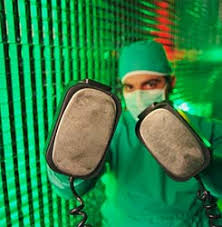
In my first job, sometimes, we had to perform post-mortems on animals that had suddenly died or if they passed away without a diagnosis. The purpose of a post-mortem is to find out the cause of death for the owner's peace of mind or for our future reference.
Post-mortems involve dissecting the body of the animal. The whole body is cut up and then closely examined. Tissue samples are also taken for analysis. There was one old Border Collie dog that had suddenly died with no previous signs of deterioration and the owner was curious to find out the cause of death.
The dog presented to my clinic late in the evening on a Friday night. The dog was already dead but the owners wanted a post-mortem to be performed to investigate the cause of death. Normally, post mortems are best performed as soon as possible when the tissue is still relatively "fresh". So I was given the joyous task of cutting up the body and taking samples. The owner had agreed for the dog to be cremated straight after the post-mortem. Owners are aware that a post-mortem is a bit of a butcher's job; chopping up the body and taking pieces from it to send for histopathological analysis.
I proceeded with the unpleasant job of mutilating this dead Border Collie. I made a huge incision from the chest and along the abdomen. I took samples from all the vital organs and found that the dog had multiple tumour nodules in the lungs. After chopping the poor carcass into pieces, I had finished a thorough post-mortem and collected enough samples to send for analysis.
Because the owner had already agreed for the body to be cremated (not buried whole), I made the decision that I would not stitch close the chest and abdomen after the post-mortem. My reasoning was that it would take quite a long time to do and since the dog's body was going to be burnt anyhow, it would have made no difference. So I proceeded to place the mutilated dog's body into a bag and then into a freezer awaiting collection from the pet crematorium.
I went off for the weekend thinking no more of the dog. Over the weekend, our clinic allocated one vet to be on duty - dealing with any emergencies. The vet on duty that weekend was a lovely girl called Sharon, who went out of her way to accommodate clients. That Sunday, the owner of the Border Collie rang Sharon asking her if it would be possible to see the dog's body for one last time. Normally, the dog's remains would have been sent to the crematorium immediately but since it was the weekend, the body was to be collected on Monday.
Being a sweet person, Sharon agreed to come into the clinic and prepare the body for viewing, not aware of how I had left the remains. When she arrived at the clinic, she took the dog out of the freezer and removed the body from the bag. To her surprise, she found the dog in the mess that I had left it in; with the body open and the organs dangling around! She obviously knew that this image was not appropriate as a last visual memory of the owner's cherished pet. She kindly decided to suture up the body for presentation to the client. The problem was that the body was completely frozen and rock hard - impossible to stitch up.
Sharon needed for the dog to thaw before applying her cosmetic touch! Anyone who had ever defrosted any meat is well aware, this can take some time. She informed the owner that they could come and see the corpse later as she was busy at the moment. Normally, microwaves are great for defrosting meat for consumption but I've never seen a microwave big enough for a Border Collie (which is a good thing!).
Sharon decided to allow the cadaver to thaw and warm up naturally. She placed the dog next to a radiator on maximum heat and on a electric heatpad. On top of this, the dog was covered in hot water bottles. After a few hours, the body was softer and Sharon was able to stitch the dog up. The owner came in and had their everlasting image of their beloved pet imprinted into their memory bank. If only they knew how much effort Sharon had made!
When I heard the story on Monday after coming back from a pleasant weekend, I felt terrible and awfully guilty. I bought Sharon a bottle of wine to apologise for creating so much stress and work for her. After that weekend, I think Sharon wanted a nice break to unwind - maybe a spa. My boss at the time maybe should have installed a sauna into the clinic - for vets to relax and for quick defrosting of dead bodies!



































